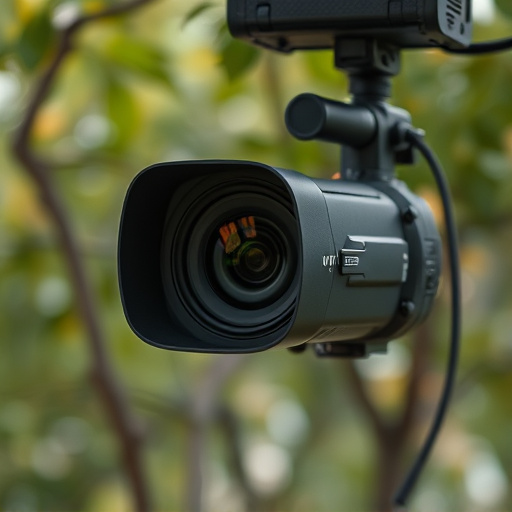Wireless Nanny Cams without an internet connection offer discreet, efficient home security monitoring via a local network, sending alerts and footage to smartphones or computers. These tiny yet powerful devices can be strategically placed in various locations for undetected surveillance, but raise ethical privacy concerns, requiring compliance with regional regulations on consent. Secure access involves WPA2/WPA3 encryption, a firewall, VPN server, and firmware updates; key features include motion detection, night vision, two-way audio, and remote access for optimal monitoring.
Uncover the unseen with hidden surveillance devices, especially the powerful Wireless Nanny Cam without an internet connection. This comprehensive guide explores common locations these cameras are strategically placed—from silent observation in home offices to discreet monitoring in outdoor areas. We demystify their operation, from understanding wireless connectivity to advanced features, while navigating ethical boundaries and legal implications. Learn how to set up a secured network for remote access, ensuring privacy without sacrificing security.
- Understanding Wireless Nanny Cams: No Internet Required
- Common Spots for Hidden Surveillance Devices
- Ethical Considerations and Legal Implications
- Setting Up a Secured Network for Remote Access
- Advanced Features to Look Out For in Standalone Cameras
Understanding Wireless Nanny Cams: No Internet Required
Wireless Nanny Cams have revolutionized home security by offering a discreet and effective monitoring solution. Unlike traditional cameras that require an internet connection, these innovative devices operate independently, sending alerts and video footage to your smartphone or computer via a local network. This means no constant data usage or reliance on an active internet connection—a significant advantage for privacy-conscious users.
These cams are equipped with Wi-Fi capabilities but can function seamlessly without it. Once set up, they create their own private network, ensuring that your footage remains secure and accessible only to authorized devices. This feature makes them ideal for remote monitoring, allowing you to keep an eye on your home or office from anywhere in the world—all without incurring additional data costs.
Common Spots for Hidden Surveillance Devices
In the age of advanced technology, hidden surveillance devices have become more sophisticated and accessible, with options like wireless nanny cams without internet connection leading the way. These tiny yet powerful tools can be strategically placed in various spots to monitor activities discreetly. Common locations for such devices include areas around entry points like doors and windows, where potential intruders are likely to be observed.
Another frequent hiding place is inside or near electrical outlets and switches, as these often go unnoticed while offering easy access for surveillance. Additionally, hidden cameras can be placed behind mirrors, potted plants, or even within everyday objects like clocks and smoke detectors, taking advantage of their ordinary appearances to maintain an element of surprise.
Ethical Considerations and Legal Implications
Hidden surveillance devices, such as wireless nanny cams without internet connection, raise important ethical considerations and legal implications. While these cameras can offer peace of mind for parents or homeowners, their use can infringe on privacy rights if not properly regulated. The placement of such devices in common spots like bedrooms, bathrooms, or areas with high personal interaction triggers debates about consent and the right to privacy.
Legally, the regulations surrounding hidden surveillance vary by region. In many places, there are strict rules prohibiting the installation of cameras without explicit consent from individuals who may be recorded. Using a wireless nanny cam in common areas could constitute a breach of these laws, leading to legal consequences for the owner. It’s crucial to understand and respect privacy laws to ensure ethical use of hidden surveillance devices.
Setting Up a Secured Network for Remote Access
To set up a secure network for remote access, especially when using a Wireless Nanny Cam Without Internet Connection, it’s crucial to understand the importance of encryption and secure protocols. Enable strong WPA2 or WPA3 encryption on your Wi-Fi network to protect data transmission. Use a dedicated firewall to control incoming and outgoing traffic, blocking unauthorized access points and devices.
Consider setting up a Virtual Private Network (VPN) server to create an encrypted tunnel for remote access. This ensures that even if someone manages to intercept the signal, they won’t be able to decipher the data due to end-to-end encryption. Regularly update firmware on your router and camera to patch security vulnerabilities and ensure uninterrupted, secure monitoring from anywhere.
Advanced Features to Look Out For in Standalone Cameras
When considering a wireless nanny cam without internet connection, look for advanced features that enhance its effectiveness and convenience. Motion detection is a must-have; it alerts you to any activity via real-time notifications or recorded clips, ensuring you don’t miss crucial moments. Night vision capabilities are also essential, allowing the camera to capture clear images even in low-light conditions, providing around-the-clock monitoring.
Additional features like two-way audio and remote access further elevate the functionality of a standalone camera. Two-way audio enables communication between you and the person being monitored, while remote access allows viewing and controlling the camera from your smartphone or tablet, offering flexibility and peace of mind no matter where you are.
Hidden surveillance devices, particularly wireless nanny cams operating without an internet connection, offer a level of discretion and accessibility. By understanding common placement spots like hidden corners in rooms or under furniture, you can better protect your privacy or monitor sensitive areas. However, it’s crucial to navigate ethical boundaries and legal implications, ensuring remote access through secured networks. When selecting a standalone camera, look for advanced features enhancing functionality and security, ensuring peace of mind without compromising on privacy.
